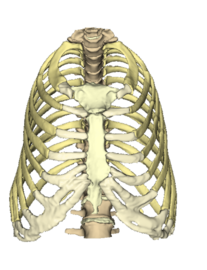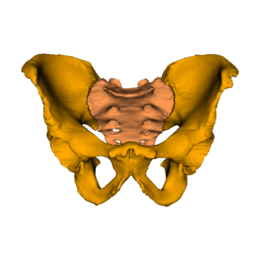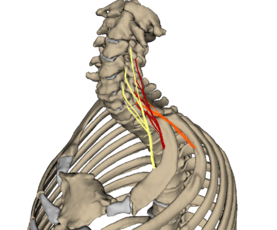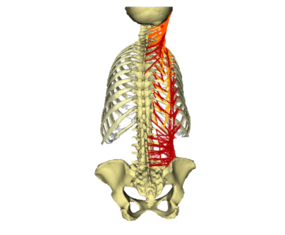Trunk wall
Inhaltsverzeichnis
Subdivision of the trunk
trunk skeleton
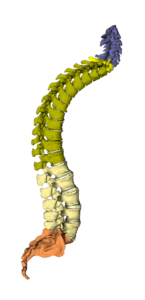
Spine
Bony spine
Structure of a vertebra
Cervical spine
Thoracic spine
Lumbar spine
Sacrum and coccyx
Muscles of the anterior and posterior trunk
Abdominal and thoracic muscles
Chest muscles
Front and posterior abdominal wall muscles
Lateral, oblique abdominal wall muscles
Autochthonous back muscles
Back muscles - medial tract
Back muscles - lateral tract
Short neck and head joint muscles
Inguinal canal (Coming soon)
Definition
The trunk, anatomically also known as the truncus, includes the spine, thorax, abdomen, dorsum and pelvis. The thorax is formed by the thoracic spine, ribs and sternum. The pelvic and shoulder girdle, also part of the trunk skeleton, enable the human being to walk upright.
Almost all organs, except the brain and the skin, are located in the trunk or distributed in the individual sections. The abdomen contains the stomach, small and large intestine, spleen, liver, kidneys and pancreas. The chest contains the heart and lungs. The bladder and sexual organs are located in the pelvis.
Function and tasks
The trunk skeleton and the musculature ensure the stability of the upper body. It is only thanks to the bones and muscles in the trunk that people can walk and stand upright. In addition, almost all important organs of the body, with the exception of the brain, are located in the trunk. Most digestive organs such as stomach, small intestine, large intestine, spleen, pancreas and liver are located in the abdomen. The liver is the body's most important metabolic organ. It is particularly important for nutrient processing and detoxification of the body. The kidneys, which also belong to the abdominal organs, filter the blood and support the excretion of metabolic waste products. Another function is the regulation of blood pressure and water balance. The chest contains both heart and lungs. The heart is the central organ for blood circulation. The lungs enrich the blood with oxygen. Carbon dioxide is extracted from the blood and breathed out. The bladder, the urinary tract and the sexual organs are located in the area of the pelvis. The urine produced in the kidneys is excreted via the bladder and the urinary tract. The reproductive organs are primarily used for reproduction.
Anatomy and Structure
Der untere Teil des Rumpfes ist das Becken. Dieses besteht aus den beiden Hüftbeinen (Ossa coxae) enthält die innenliegenden Beckenorganen. Der Bauch befindet sich zwischen Brustkorb (Höhe Brustbeinspitze) und Becken (bis zum Leistenband). Innerhalb des Bauches ist ein flüssigkeitsgefüllter Hohlraum - die Bauchhöhle oder auch Bauchraum. Das Zwerchfell bildet die obere Grenze des Bauchraumes. Unterhalb wird er vom Hüftbein und dem Beckenboden begrenzt. Der Rücken reicht von der Lende bzw. Steißbein bis zum unteren Bereich des Nackens. Dazu zählen die Wirbelsäule, die hinteren Anteile der Rippen und Weichteile wie Bindegewebe und Rückenmuskulatur. Der Brustkorb wird von der Brustwirbelsäule, dem Brustbein und den Rippen gebildet. Die Atemmuskulatur setzt außen und innen am Brustkorb an.
